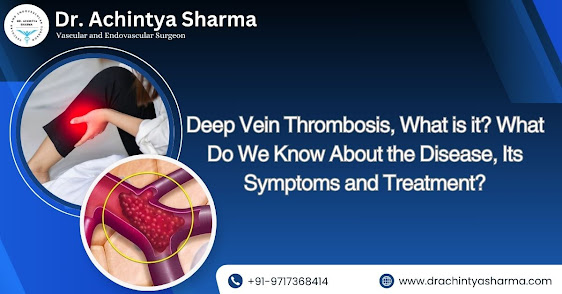Deep Vein Thrombosis, What is it? What Do We Know About the Disease, Its Symptoms and Treatment?
What Is Deep Vein Thrombosis?
DVT happens when a blood clot forms in a deep vein, usually in the legs or pelvis. This clot can block normal blood flow and cause swelling, pain, and other complications. A DVT clot can travel to the lungs and become life-threatening. It often happens after long sitting or bed rest. It can also affect those with clotting disorders, smokers, or people taking certain medications.
Symptoms and Causes of Deep Vein Thrombosis
Wondering how to tell if you have deep vein thrombosis? The symptoms can be subtle, but here are common signs to watch for:
Swelling in one leg (or arm)
Pain or tenderness that starts in the calf
A feeling of warmth in the affected area
Skin discoloration or redness
DVT doesn’t always show obvious symptoms. That’s why it’s smart to consult a vascular specialist like Dr. Achintya Sharma if you’re at risk.
Common causes include:
Immobility for long periods
Injury to the veins
Surgery, especially orthopedic
Obesity
Genetic factors
Why Early Diagnosis and Treatment Matter
Ignoring deep vein thrombosis can be dangerous. It’s not just leg pain—it’s a silent threat that can move to your lungs or heart. But with early diagnosis, the outlook is positive.
Treatment options range from blood thinners and compression stockings to lifestyle changes and, in some cases, surgery. Dr. Achintya Sharma recommends timely Doppler ultrasound scans for high-risk individuals and emphasizes the role of regular movement and hydration.
Preventive care, especially after surgery or during travel, can lower your chances of developing DVT significantly. Knowing your risk factors is the first step to prevention.
How You Can Stay Ahead of Deep Vein Thrombosis
Now that you know the risks and signs, here’s what you can do today to protect yourself from deep vein thrombosis:
Stay active: Walk often, especially during long trips or if you sit at a desk for hours.
Hydrate: Dehydration thickens your blood.
Wear compression socks: Especially if you’re at risk.
Watch your weight: Obesity is a major trigger.
Regular check-ups: Consult experts like Dr. Achintya Sharma for personalized advice.
The key to managing it is awareness and action. Don’t wait for symptoms—start taking care of your health today.
FAQs About Deep Vein Thrombosis
1. Can deep vein thrombosis be cured?
Yes, with early diagnosis and treatment, this can be effectively managed and resolved. Medications and lifestyle changes play a big role.
2. What are the warning signs of deep vein thrombosis?
Swelling, pain, redness, and warmth in one leg are common signs. If you notice these symptoms, seek medical help immediately.
3. Is DVT life-threatening?
Yes, if not treated, DVT can cause a lung blockage called a pulmonary embolism, which can be deadly. Getting help early is key.
4. Who is at risk of deep vein thrombosis?
People who are immobile for long periods, pregnant women, smokers, obese individuals, and those with certain medical conditions are at higher risk.
5. Can exercise help prevent DVT?
Absolutely. Regular movement boosts blood flow and reduces the risk of clot formation.
Conclusion
Deep vein thrombosis is more common than you think, but it doesn’t have to be deadly. Knowing the early signs, the risks, and how to prevent DVT can truly save your life. From simple daily walks to expert-guided care, every step counts. Specialists like Dr. Achintya Sharma are leading the way in helping patients detect and manage DVT with confidence. Don’t ignore what your body tells you—take control, ask questions, and prioritize your vascular health. The journey to prevention starts with awareness, and you’ve just taken the first step.




.jpg)
Comments
Post a Comment